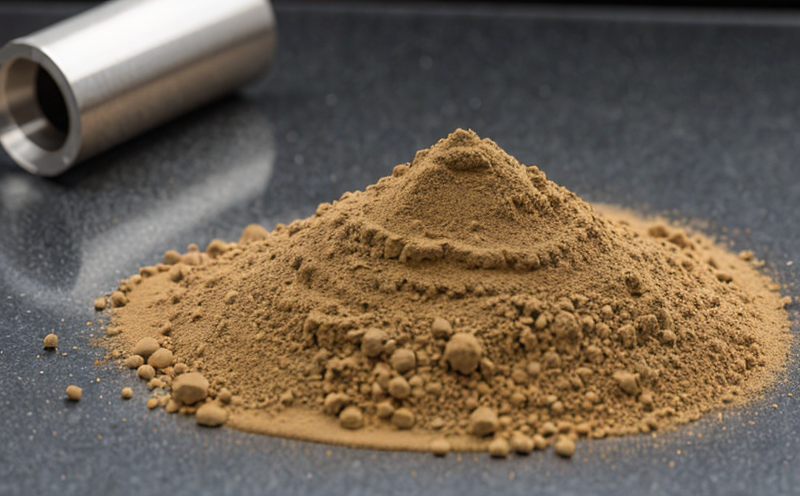ISO 13320 Particle Size Distribution Testing by Laser Diffraction
The ISO 13320 standard specifies the laser diffraction method for determining particle size distribution in powders and other granular materials. This technique is widely used to ensure that raw materials meet precise specifications, thereby guaranteeing product quality and performance.
Particle size plays a critical role in additive manufacturing (AM) processes as it directly influences processability, mechanical properties, and the final product's integrity. In 3D printing, especially for AM technologies like Selective Laser Sintering (SLS), laser diffraction testing is essential to ensure that powders are within optimal size ranges.
The laser diffraction method uses a collimated light beam directed through the particle suspension. As particles scatter this light, their intensity distribution provides information about their size. This method offers rapid and accurate measurement over a wide range of sizes from submicron to millimeter scales. It is non-destructive and minimizes sample handling, making it ideal for quality control.
For materials used in AM processes, such as nylon, metal alloys, or composites, laser diffraction can identify any inconsistencies that might affect the performance of the final product. By ensuring consistent particle size distribution, manufacturers can optimize process parameters like powder bed thickness and laser power settings to achieve desired mechanical properties.
Our laboratory adheres strictly to ISO 13320 standards, employing state-of-the-art equipment to provide reliable results. Our team of experts ensures that every sample is prepared meticulously according to industry best practices, ensuring accurate measurements and repeatable results.
The particle size distribution data obtained through laser diffraction testing can be used for various applications in AM processes, including:
- Optimizing powder bed fusion processes
- Evaluating the effectiveness of surface treatments or coatings
- Assessing the stability of composite materials during processing
- Determining the optimal conditions for binder jetting
In summary, ISO 13320 laser diffraction testing is a vital tool in ensuring that raw materials used in AM processes meet the necessary quality standards. This precision testing helps manufacturers produce high-quality parts consistently and efficiently.
Applied Standards
The primary standard for particle size distribution testing by laser diffraction is ISO 13320:2009. This international standard provides a comprehensive framework for the measurement of particle size distributions using laser diffraction techniques.
- ISO 13320:2009: Particle size distribution determination by laser diffraction
- ASTM E1582-17: Standard practice for laser diffraction particle size analysis of materials
- EN ISO 13320:2012: Determination of particle size distribution by laser diffraction
These standards ensure that the testing methods are consistent and reproducible, providing reliable data for quality control and process optimization.
Scope and Methodology
The scope of ISO 13320 laser diffraction testing includes the measurement of particle size distributions in powders, granules, and other solid materials. This method is particularly useful for raw materials used in additive manufacturing processes.
The methodology involves preparing a suspension of particles in a suitable liquid medium. The suspension is then passed through a laser beam, which scatters light according to the particle sizes present. A detector measures the scattered light intensity, and this data is processed into a particle size distribution histogram.
Our laboratory ensures that all samples are prepared using industry-standard procedures to minimize variability. This includes thorough cleaning of equipment, precise control of sample volume and concentration, and consistent laser alignment. The raw data collected during testing is analyzed using advanced software tools to generate accurate and repeatable results.
The particle size distribution histogram provides detailed information about the range of sizes present in a sample. This data can be used to identify any outliers or inconsistencies that might affect the performance of materials in AM processes. By adhering strictly to ISO 13320 standards, our laboratory ensures that every test result is accurate and reliable.
Environmental and Sustainability Contributions
The precision of ISO 13320 laser diffraction testing plays a significant role in promoting sustainable manufacturing practices. By ensuring that raw materials meet strict particle size distribution specifications, this method helps minimize waste during the additive manufacturing process.
- Reduction of material waste: Ensuring consistent particle sizes reduces the need for reprocessing and increases overall efficiency.
- Optimized energy consumption: Properly sized powders allow for more efficient use of energy in AM processes, leading to lower carbon footprints.
- Enhanced product quality: Consistent particle size distributions contribute to higher-quality products, reducing the need for post-processing adjustments.
- Better resource utilization: By optimizing material usage, this method helps extend the lifecycle of raw materials and reduce environmental impact.
In summary, ISO 13320 laser diffraction testing is not only a critical tool for quality control but also an important step in promoting sustainable manufacturing practices. By ensuring that raw materials meet strict specifications, this method contributes to more efficient processes and reduced waste.





